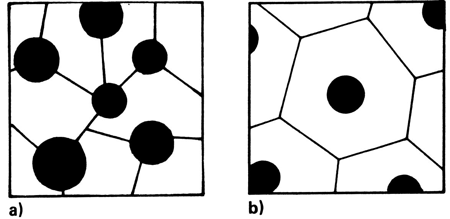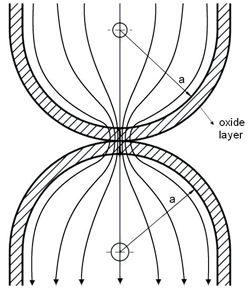2011 Hagen Symposium: A review of Spark Plasma Sintering
Various terms such as Rapid Hot Pressing (RHP), Field Assisted Sintering Technique (FAST) or Spark Plasma Sintering (SPS) are used for very similar modern short-time sintering processes. What they all have in common is that sintering is performed in a closed die under pressure and that the heat is generated by a direct or pulsed electric current running through the punches as well as through the die and/or the sample. For metals the atmosphere may be inert (argon) or vacuum.
Prof. Kieback began his presentation with a model of metal powder particles showing an oxide layer on the surface. He stated that the thickness of oxide layers, compacting pressure and particle size affect the electrical current in the initial stage of sintering.
The current is forced through the narrow contact areas between powder particles. The voltage increases at the contacts, with the magnitude of the local voltage estimated at roughly 1000 times the nominal voltage.
Kieback stated that he believes this voltage concentration is normally not high enough to create sparks. Additional effects such as an inhomogeneous distribution of contacts can lead to a reduction in the number of contacts and a higher voltage concentration. It is then that local voltages might be sufficient to generate sparks.
The pressure applied on the punches is usually between 10 and 100 MPa. Due to the reduced cross-section at the particle-to-particle contacts, the local pressure here is increased by a factor of 100, which results in theoretical local pressures of 1000 to 10,000 MPa.
These high pressures can easily break up the oxide layers and create direct metal-to-metal contacts. The real pressures, however, are limited by the yield strength of the powder. As soon as the yield strength is exceeded the particles are deformed and contact areas are created.
Once the first oxide layers have been broken by either the current or plastic deformation, and metal-to-metal contacts have been formed, the resistance of the sample drops dramatically and the current through the sample increases instantaneously. This leads to a rapid heating of the sample.
At higher temperatures the well-known mechanisms prevail by which sintering and densification is supported, namely an increasing number of vacancies and dislocations, diffusion, reduction of yield strength, and so on.
Kieback assumed that due to the voltage concentration, the current generates more heat at the particle contacts than in the inside of the particles. The impact of this effect on the speed of sintering was estimated. It was found that the heat is dissipated to the interior of the particles within milliseconds and that this could only have a significant effect for materials with a very low thermal conductivity and large particle size
External pressure strongly affects the diffusion processes in the early stages of sintering. For particle sizes between 1 and 100 microns, the densification has been estimated to be 1000 to 10,000 times faster as compared to pressureless sintering. As a consequence, the temperatures required for full densification can be 100 to 300 K lower.
In the late stage of sintering, when the shrinkage has practically come to an end, the remaining porosity (less than 5% ) consists of round, isolated pores. These pores are initially connected to grain boundaries. As grain growth proceeds, the pores can be released from grain boundaries and left in the inside the grains.

Isolated pores in the late sintering stage, a) pores connected to grain boundaries, b) pores inside grains (courtesy B. Kieback)
The total elimination of residual porosity, also called pore healing, is also assisted by external pressure. Under pressure the material adopts a “quasi-viscous” behaviour due to a high density of dislocations and vacancies. Grain boundary slip is also assumed to contribute to pore healing because it is faster than vacancy controlled diffusion.
Despite of ample research in the field of spark plasma sintering, there is little experimental evidence of what really happens inside samples during SPS. The speaker questioned the importance of alleged electrical effects such as sparks, plasma, heat diffusion, electromigration, or electron wind because they have not been proven experimentally.
In the light of this analysis, spark plasma sintering appears not to be fundamentally different from traditional hot pressing, except that the current leads to a much faster heating rate. There is no doubt, however, about the advantages of the very high heating rates, short sintering cycles and low sintering temperatures that are achieved by SPS.
News | Articles | Market reviews | Search directory | Subscribe to e-newsletter






